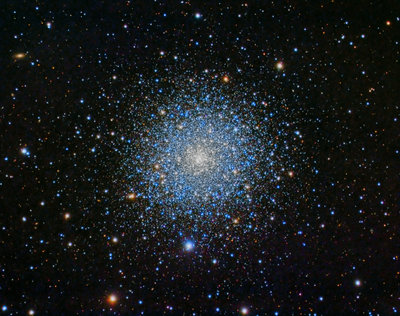by KuriousGeorge » Mon Jun 26, 2017 3:11 pm
M92, Copyright KG Observatory.
M92 is a globular cluster of stars in the northern constellation of Hercules. M92 is at a distance of about 26,700 light-years away from Earth.
Among the Milky Way population of globular clusters, M92 is among the brighter clusters in terms of absolute magnitude. It is also one of the oldest clusters.
Imaging telescope or lens: Celestron 8" EdgeHD
Imaging camera: QSI 660 WSG
Mount: Losmandy G-11
Guiding camera: Starlight Xpress Ultrastar
Software: PHD Guiding 2, PixInsight 1.8, Neat Image V7, Photoshop CS3, Sequence Generator Pro, Maxim DL6
Filters: Astrodon 1.25" R, Astrodon 1.25" B, Astrodon 1.25" G, Astrodon 1.25" L
Accessories: Innovations Foresight ONAG SC, Optec FocusLock, Starizona MicroTouch Autofocuser
Resolution: 2604x2056
Dates: June 17, 2017, June 18, 2017, June 25, 2017
Frames:
Astrodon 1.25" B: 58x120" -15C bin 1x1
Astrodon 1.25" G: 58x120" -15C bin 1x1
Astrodon 1.25" L: 93x120" -15C bin 1x1
Astrodon 1.25" R: 57x120" -15C bin 1x1
Integration: 8.9 hours
Darks: ~20
Flats: ~80
Flat darks: ~80
Bias: ~20
Mean SQM: 19.75
RA center: 259.281 degrees
DEC center: 43.136 degrees
Pixel scale: 0.642 arcsec/pixel
Locations: Home, Rancho Santa Fe, California, United States
- Attachments
-

M92, Copyright KG Observatory.
M92 is a globular cluster of stars in the northern constellation of Hercules. M92 is at a distance of about 26,700 light-years away from Earth.
Among the Milky Way population of globular clusters, M92 is among the brighter clusters in terms of absolute magnitude. It is also one of the oldest clusters.
Imaging telescope or lens: Celestron 8" EdgeHD
Imaging camera: QSI 660 WSG
Mount: Losmandy G-11
Guiding camera: Starlight Xpress Ultrastar
Software: PHD Guiding 2, PixInsight 1.8, Neat Image V7, Photoshop CS3, Sequence Generator Pro, Maxim DL6
Filters: Astrodon 1.25" R, Astrodon 1.25" B, Astrodon 1.25" G, Astrodon 1.25" L
Accessories: Innovations Foresight ONAG SC, Optec FocusLock, Starizona MicroTouch Autofocuser
Resolution: 2604x2056
Dates: June 17, 2017, June 18, 2017, June 25, 2017
Frames:
Astrodon 1.25" B: 58x120" -15C bin 1x1
Astrodon 1.25" G: 58x120" -15C bin 1x1
Astrodon 1.25" L: 93x120" -15C bin 1x1
Astrodon 1.25" R: 57x120" -15C bin 1x1
Integration: 8.9 hours
Darks: ~20
Flats: ~80
Flat darks: ~80
Bias: ~20
Mean SQM: 19.75
RA center: 259.281 degrees
DEC center: 43.136 degrees
Pixel scale: 0.642 arcsec/pixel
Locations: Home, Rancho Santa Fe, California, United States